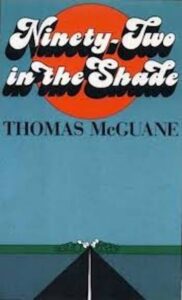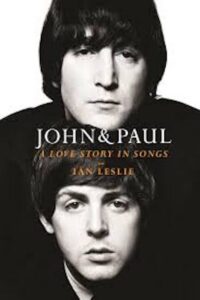Ninety-Two in the Shade

By Thomas McGuane
Published 1973
208 Pages
This was one of two books I read for the latest meeting of The Mules (my book club). I’d never read McGuane before, but Ninety-Two in the Shade came recommended from one of our younger members who’s got a sharp eye for good books, so I figured why not give it a shot. And it was worth it! But while I enjoyed it, most of the others didn’t. Outside of the guy who picked it and me, only two gave it a thumbs-up. The rest found it so annoying they couldn’t even finish it. We’ve had our disagreements before, but this was one of our biggest splits yet.
What It’s About
Ninety-Two in the Shade is the weird tale of Tom Skelton, a young man from an old Key West family who returns home to become a fishing guide. But this isn’t your typical Hemingway adventure. Tom lives in an abandoned airplane fuselage, has a carefree schoolteacher girlfriend named Miranda, and navigates a town full of misfits. His family is a mess: a bitter grandfather with shady past, a father crippled by a failed blimp factory and a failed whorehouse, and a mother who just keeps cooking through it all. At the docks, Tom gets into it with two other guides, Nichol Dance and Faron Carter. After a prank turns into a serious feud, Nichol threatens to kill Tom if he ever tries to work as a guide. The tension builds from there.
What I Liked About It
The whole book gives off a kind of wild, humid darkness that feels both literary and lethal. It’s like Hemingway if he’d been hanging out with early Cormac McCarthy, but with more jokes thrown in. McGuane’s sense of language is razor sharp. His sentences sparkle with cynicism and poetry.
Some standout elements:
* The whole setup is soaked in fatalism – Skelton’s choice to go forward with life despite a death threat feels like a metaphor for something bigger.
* The characters are vivid, strange, and memorable: the bedridden father who smells like Faulkner, the scheming grandfather, the girlfriend with her shifting morals.
* The subplots – like Goldsboro’s secret affair or Jeannie’s obsession with baton twirling – make the book feel lived-in.
* My favorite lines include: “It’s just that when you realize that everyone dies you become a terrible kind of purist” and the opening salvo, “Nobody knows, from sea to shining sea, why we are having all this trouble with our republic…”
What I Didn’t Like So Much
The plot can be hard to follow, and some scenes feel less like storytelling than stylistic exercises. That didn’t bug me, but several members of The Mules found it frustrating – enough so that they didn’t finish the book. If you need everything spelled out clearly with a tidy ending, look elsewhere.
Critical Reception
* “Thomas McGuane makes the page, the paragraph, the sentence itself a record of continuous imaginative activity…. He is an important as well as a brilliant novelist.” – The New York Times Book Review
* “A fine novel by an extraordinarily gifted writer…. His prose is vivid, ironic, filled with surprising and revealing insights.” – Washington Post Book World
* “Few writers have explored our national malaise as persistently – or as elegantly – as Thomas McGuane, a writer whose command of the language has helped define our American loneliness.” – Philadelphia Inquirer
The novel was nominated for the National Book Award.
Interesting
* McGuane was the first American novelist to adapt and direct his own novel as a feature film.
* While married to one of the film’s stars, he reportedly had an affair with another actress during filming. That tells you something about the energy behind the writing – wild, impulsive, a bit unhinged.
* The vibe of decay and eccentricity in Key West – especially in the family manse – feels like an ode to the ruined South, but without the nostalgia.
My Rating
* Verticality: 4.4 – Sharp commentary on character, fate, and Southern decay.
* Horizontality: 4.1 – Narrow setting, but deeply explored.
* Literary Richness: 4.7 – Sentence by sentence, it dazzles.
* Average Score: 4.4
* Bonus Points: 0.2 – For being so strangely unforgettable.
* Total Score: 4.6 out of 5.0 – Strongly recommended, but not for everyone.
John & Paul: A Love Story in Songs

By Ian Leslie
Published 2024
368 pages
I’m still in the middle of this one, but I’m recommending it anyway because I already know it’ll be hanging out on my nightstand for a while – a chapter here, a chapter there. I didn’t need to finish it to be sure I was going to enjoy it. Ian Leslie is a psychology writer, and here he brings that background to bear on a compelling theory: that the emotional power of Lennon and McCartney’s songs grew directly from the emotional force of their friendship.
What It’s About
At its core, the book is a study of collaboration – how two imperfect, gifted teenagers met, merged, and created the most iconic songwriting partnership in modern music. Leslie traces the evolution of their bond from a Liverpool bedroom to the world stage, using close readings of the songs themselves as milestones in their deepening – and eventually unraveling – connection.
What I Liked About It
The Beatles were, and probably still are, my favorite band. Their music was the soundtrack of my adolescence and remained important to me into my 20s, even as I developed other musical loves – Simon & Garfunkel, Otis Redding, Richie Havens, Cat Stevens. So naturally I was drawn to a book that revisits the Beatles’ early days with a fresh angle: that the secret to their genius lay not just in talent, but in the emotional synergy between two complicated young men.
Some of Leslie’s best insights:
* Lennon and McCartney, even as teenagers, weren’t content to copy American R&B acts. They wanted to be heard.
* Their first encounter was electric – Paul playing “Twenty Flight Rock” for a skeptical John, who was quickly won over.
* From the beginning, they dreamed not just of performing, but of writing songs like their idols – Leiber and Stoller, the Gershwins.
* By the time they were singing face-to-face in some dingy Hamburg club, guitars mirroring each other across a mic, their musical chemistry was unmistakable.
Leslie is especially good when he explores how early trauma fueled their creative output. Both boys lost their mothers while still in their teens. Those wounds were deep – and unspoken – but they haunted and shaped the music. The emotional weight in songs like “We Can Work It Out” or “Two of Us” hits differently when you understand the losses underneath them.
What I Didn’t Like So Much
Not much. I didn’t share Leslie’s relatively generous take on Wings, and wish he had gone deeper into some of Lennon’s post-Beatles solo work. But these are preferences, not criticisms. The prose is smart but never precious, and the emotional tone stays grounded even when the subject is mythic.
Critical Reception
* “We think we know everything, but author Ian Leslie proves otherwise. His new book, John & Paul: A Love Story in Songs, is, astonishingly, one of the few to offer a detailed narrative of John Lennon and Paul McCartney’s partnership. And it’s a revelation.” – Los Angeles Times
* “A celebration of the convoluted, beautiful, and tragic nature of a songwriting partnership that still reverberates across the universe.” The Wall Street Journal
* “Leslie does an extraordinary job of providing context for familiar anecdotes, and there are many that will feel surprising.” – USA Today
Interesting
* Leslie calls “She Loves You” a miracle of structure and energy that’s “easy to miss because its effect is so immediate.”
* The intense way Lennon and McCartney locked eyes – during early jam sessions and even later acid trips – is portrayed as both an artistic tool and a strange kind of intimacy.
* On the night after Lennon’s assassination, McCartney’s flat public remark – “It’s a drag, isn’t it?” – is reinterpreted by Leslie as the stunned voice of a bereaved child, emotionally mute.
* One of the book’s most moving scenes describes how John and Paul, during one of their final sessions, record “The Ballad of John and Yoko” by themselves – just the two of them, one last time.
My Rating
* Verticality: 4.5 – Deep insight into emotional themes and collaborative genius.
* Horizontality: 4.7 – Rich cultural context, personal narrative, musical history.
* Literary Richness: 4.4 – Smart, clear, and occasionally poetic prose.
* Average Score: 4.54
* Bonus Points: 0.3 – For shedding light on the emotional interior of two icons.
* Total Score: 4.7 out of 5.0 – Strongly recommended.
My Rating System for Most Books
Each book is evaluated – from 0 to 5 – in terms of three categories:
1. Verticality – How deeply did the book go in mining the depths of the human experience?
2. Horizontality – How much and how well did the book provide a sense of a particular place, time, community, and/or culture?
3. Literary Richness – How well did the writing enhance the story?
I calculate the book’s average score – and sometimes, as you can see in both of my reviews today, I add bonus points for something I felt was especially good.
Then, based on its total score, I deliver mv verdict.
